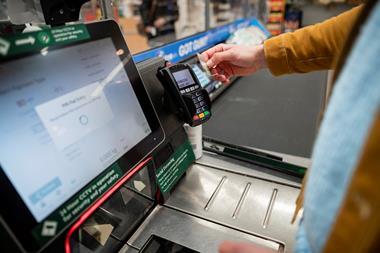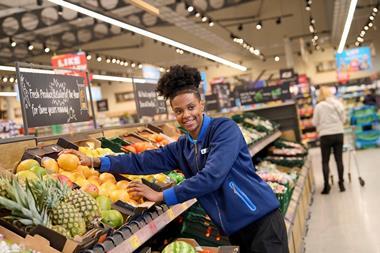The supermarkets are raising their game in clothing with a greater emphasis on quality as well as value, backed by a ramped-up presence online. Chloe Ryan reports
When Anthony Thompson took over at George in 2007, he declared he wanted Asda to be the UK's number one clothing retailer by 2011. This autumn, he achieved his goal 18 months early, leapfrogging Primark, Tesco and his former employer Marks & Spencer to do just that in terms of volume sales.
The coup marks a return to form for the retailer, which had not held the top spot since 2005. And it isn't the only supermarket chain that's dressing to impress once more, having focused primarily on food so far during the recession.
Tesco has just launched its clothing website, clothing boss Terry Green vowing to steal the crown from Asda, and Sainsbury's has just appointed a new head of its Tu clothing brand, Sara Bradley, who has pledged to focus more heavily on clothing as it grows its non-food offer.
So why is clothing suddenly back in vogue with the supermarkets? And does Asda's resurgence signal the beginning of a new era of supermarket dominance over high-street rivals?
Way before Tesco's £45 tribute to Kylie's Chloe dress and Asda's £3 pair of jeans, supermarket clothing was all about cheap and cheerful, so it is surprising that they've waited until almost a year into the recession to start banging the clothing drum.
Some of their reticence may be down to the media-stoked backlash against cheap clothing. Although not the only targets, the supermarkets have had plenty to do on the damage limitation front in the wake of exposés of the use of cheap foreign labour or worse, child labour.
Neither the media nor the general public, it seems, have been entirely persuaded by their claims that it is possible to make high-quality, low-priced clothing without someone paying a price.
Witness last month's Let's Clean Up Fashion report, which accused Tesco and Asda among others of exploiting factory garment workers in Asia by failing to pay them enough to live on.
The supermarkets have also been held back by their lack of an online clothing presence, which not only stopped them from fully capitalising on the barrage of positive PR in the fashion press a few years ago but allowed the likes of online retailer Asos to build market share unchallenged. Not any longer. With Tesco and Asda now online, there's a real opportunity to ramp up their clothing offers and take the fight to web as well as high street retailers bad news for the latter in particular.
Although Primark continues to ride high, this week reporting an 8% rise in profits for the year and a 20% rise in sales, other clothing retailers, particularly the mid-market players, are having a torrid time. According to the Local Data Company, the number of women's and children's wear retailers fell 17.9% between January and September, while the number of menswear retailers fell 12.4%.
Yet, as Primark's results demonstrate, the recession presents as much of an opportunity as a threat for those in the high-volume, low-price game. Shopping habits have changed dramatically in the downturn. A poll of 1,032 consumers by TNS Omnibus for The Grocer reveals that more than a third (34%) are spending less on clothes than a year ago, with just 9% spending more, and 75% claim they prefer to buy clothes that last rather than throwaway fashions.
Asda has spent the last two years streamlining George, taking out 30% of lines and stripping out numerous sub-brands, as well as improving quality, says Thompson.
"Our customer base has grown massively in the recession," he claims. "I'm not going to pretend the environment has not worked in our favour it has," he says.
"But in clothing, value for money is not about cheapness. It is about quality, style and value. We've improved the cotton, we've improved the denim, we've improved all the fabrics on schoolwear. It's not about cheap throwaway clothes any more."
Asda's rivals echo Thompson's point that it has moved on from the 'fast fashion' that allowed them to compete with the likes of Primark but saw quality sacrificed at the altar of price.
Shoppers are increasingly looking for quality, agrees Bradley, citing the recent cashmere cardigan frenzy. "Cashmere knitwear gets a real lift in the run up to Christmas as a gift purchase, as does some of our nightwear and slippers," she says. "People are making things last a bit longer and only buying a new pair of black trousers if they really need to. Where there is something new and different in clothing, they are buying into that. It makes them feel good and cheers them up a bit."
Speaking at the launch party for the Tesco clothing website last month, Green illustrated the challenge facing high-street retailers. "This Tesco suit I am wearing is 100% wool," he said. "It is made in China, it is exactly the same suit as you would find in M&S for £199, but costs £99. The value equation really drives the engine of Tesco."
Given the supermarkets' buying power, this would perhaps more accurately be described as the value-volume equation. With Tesco's and Asda's moves online, those volumes are set to rise further still, which, hopes Green, will have a knock-on effect on value sales. Tesco has set out its stall to generate 10% of its annual £1bn clothing sales online. Although like Asda, it has a decent share of the market volume-wise, it is languishing behind Marks & Spencer in terms of value.
"The issue is we only have 3% of the market," says Green. "The internet is important for three reasons. Forty million people have access to a computer and the internet, 25 million people buy online and they spend £50bn. That is growing at a rate of 30% per annum and within that spend, £5bn is spent on clothing. Clothing is growing at a rate of 32% per annum, making it the fastest-growing category on the web."
The beauty of online is that it also allows retailers to diversify into territory that would be too risky in-store. Tesco is launching a new range of £100-plus clothing online, a move that, interestingly, coincides with George Davies' launch of affordable luxury chain GIVe. In a bid to boost both its online and in-store offers, the retailer is also talking to designers about creating 'diffusion brands' along the lines of Designers at Debenhams. It has already launched a range of handbags designed by The OC actress Mischa Barton as well as in-house sub-brands Liquorish and Monkee Genes.
Asda and Sainsbury's will also be plotting their next moves not least because clothing is a great way for the supermarkets to mitigate poor sales elsewhere in non-food. "Electronics and homewares are suffering so they are looking to compensate for that by expanding in clothing," says Planet Retail analyst Greg Hodge. "Asda has seen very good growth in George and other supermarkets are trying to replicate that."
The question is: can high-street retailers? The supermarkets defend themselves against accusations of labour exploitation by arguing that although they don't pay much per garment, the size of their orders make up for it. Whether you accept this view or not, their buying clout and sheer economies of scale are going to make life tougher still for other clothing retailers.
"I don't think supermarket clothing is going to kill the high street," says Thompson. "But I do think the days of selling clothing in the supermarket as a fringe activity in retail are over."
Chilling words given that few would describe it as a fringe activity now.
Sign in to comment on this article
Not logged in before? Register for FREE guest access today.
You will be able to:
- Read more stories
- Receive daily newsletters
- Comment on stories
Advert
















No comments yet